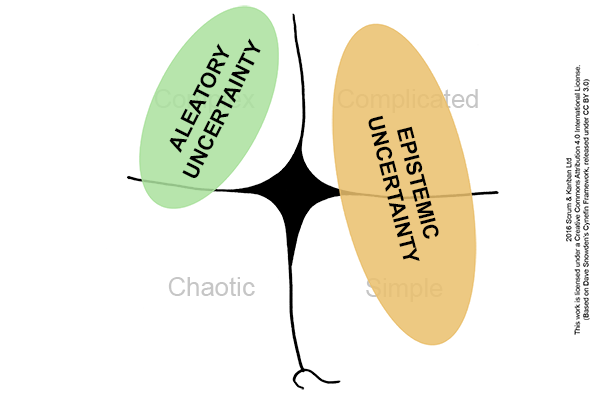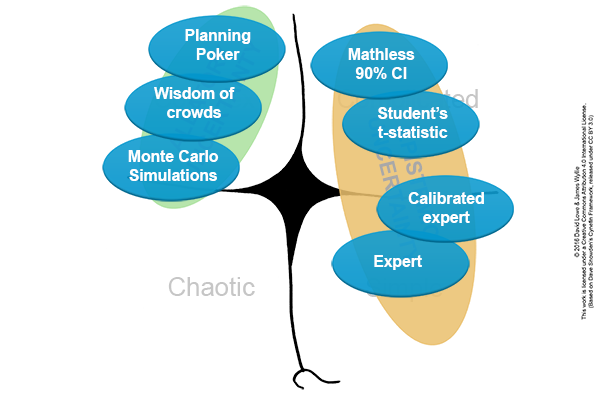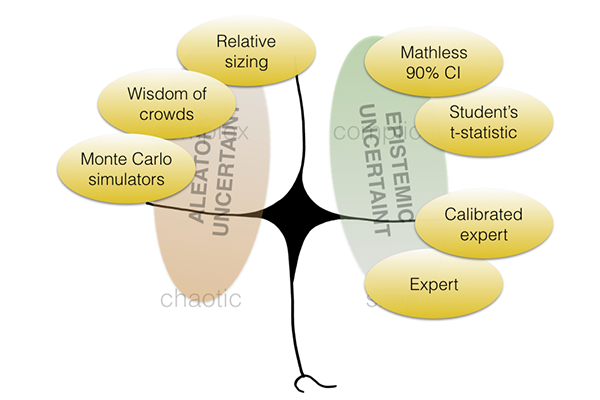Question: Which provides a better estimate: Planning Poker or an 'expert'?
Many teams would answer that question by saying Planning Poker is always better than an expert’s estimates. We’ve been told it’s the case so many times, that few question it.
Truth is, an expert estimate is sometimes more appropriate than an estimate created using Planning Poker. Sometimes it’s not. What is important is to use the most appropriate method for the situation. Here’s an introduction to what we’re calling ‘context-based estimation’:
1. Evaluate the situation
First you need to understand the context and environment that you are in. Dave Snowden’s Cynefin framework has four domains to describe the situation (if you’re new to this idea, see our blog post on Cynefin).

2. Understand the type of uncertainty
Most situations that fall in the simple or complicated domains can be described as having epistemic uncertainty: something you don’t know but is, at least in theory, knowable. I don’t know how to build a car engine but it is possible to estimate this given enough information. The cause and effect are often known before the event.
Aleatory uncertainty, on the other hand, is found in our left-hand domains: something you not only don’t know; it is unknowable. However much information I have, even if they play as well next season, it is impossible for me to know whether Leicester City will win the Premier League again next year. This type of uncertainty is full of accidental causes, is often dependent on contingent events, and is sometimes down to plain old chance.

3. Choose my estimation/forecasting approach accordingly
Now that we know what type of environment we are in and what type of uncertainty we face, we can pick an appropriate estimation/forecasting approach. For example, when faced with a situation in the simple domain, an expert guess will suffice. If required to estimate a scenario in the complicated domain, a loosely mathematic forecast can be made – because a bell curve distribution is likely. When we are looking aleatory uncertainty in the eye, getting multiple data points and aggregating the data is probably going to serve us better.

So what about Planning Poker? I’ve often said that the biggest benefit of Planning Poker is the conversations that need to occur in order for sizing to take place, but if we judge this crowd-like estimation according to James Surowiecki’s 4 conditions (see recent post on The Wisdom of Crowds), it doesn’t fare well: although the first round of Planning Poker gives independent thought, that’s gone by round two; a team’s diversity of opinion, if ever present, will dwindle quickly as a small team works closely together with shared experiences and goals; few companies truly have decentralisation; although Planning Poker works towards consensus, it isn’t really making much of aggregation; that leaves just decentralisation, which Surowiecki acknowledges is usually missing in most companies. So, as a method, Planning Poker is far from perfect. Getting a wider number of data points is often a good route when you’re in the complex domain: this could take the form of crowd-sourcing opinion or running thousands of scenarios, using ranges for as many variables as you have, in Monte Carlo simulations.
If you find yourself in the chaotic domain, you need to forget estimating and do something NOW! If your house is on fire, you don’t start calculating how much water you need to put the fire out; you just act.
Is that all?
Certainly not. We’ve not talked about revisiting estimates. We’ve not talked about whether you should estimate at all. We’ve not covered how to reduce uncertainty. In fact, we’ve only scratched the surface on this topic, but at least we’ve made a start in acknowledging that the method needs to suit the situation.

Great way to look at the investment in estimates and the diminishing returns. Simple (known) problems require less investment for similar results.
I’d be interested to know what Dave Snowden thinks of this interpretive use for Cynefin!
Yes, maybe I didn’t make it clear that the the use of simpler methods (for situations with epistemic uncertainty) benefit from being much quicker to generate. I keep meaning to tweet Dave to get his thoughts.
Thanks to Mark Kennedy for his feedback on this post.
The questions around estimation and the Complex Domain remains (at the time of writing) a point of dispute.
Dave Snowden has stated:
“I would say you estimate is different in the main three domains but not Impossible” (1)
The question for portfolio planning is ‘Is estimation a negative attractor in the situation where we want microwave ovens whilst researching radar not being able to know that if an unforeseeable event happens radar research can lead to microwave ovens?’
We could estimate the research tasks but is that valuable or even desirable?
There is also a question about systems that are like the ‘weather’ – not logically predictable but rather strongly dispositional to the point of predictability.
I suggested they might be a variant of complicated problems rather than complex.
In response to a tweet by Keith Braithwaite Dan North suggested such situations were
“not intractable, irreducible. I can predict weather ranges but not every gust.”(2)
1. https://twitter.com/snowded/status/732226047379378176
2. https://twitter.com/tastapod/status/732264648985214976